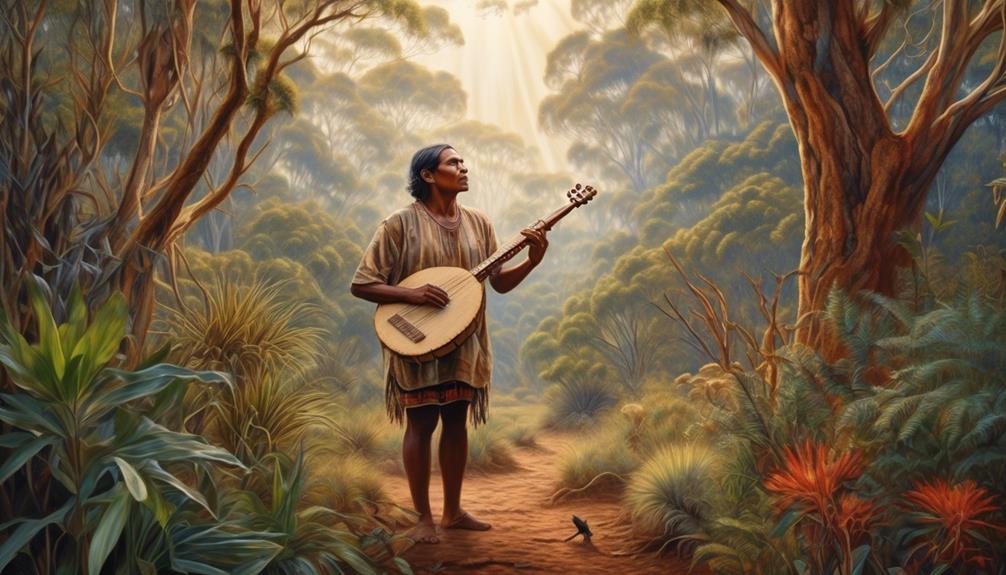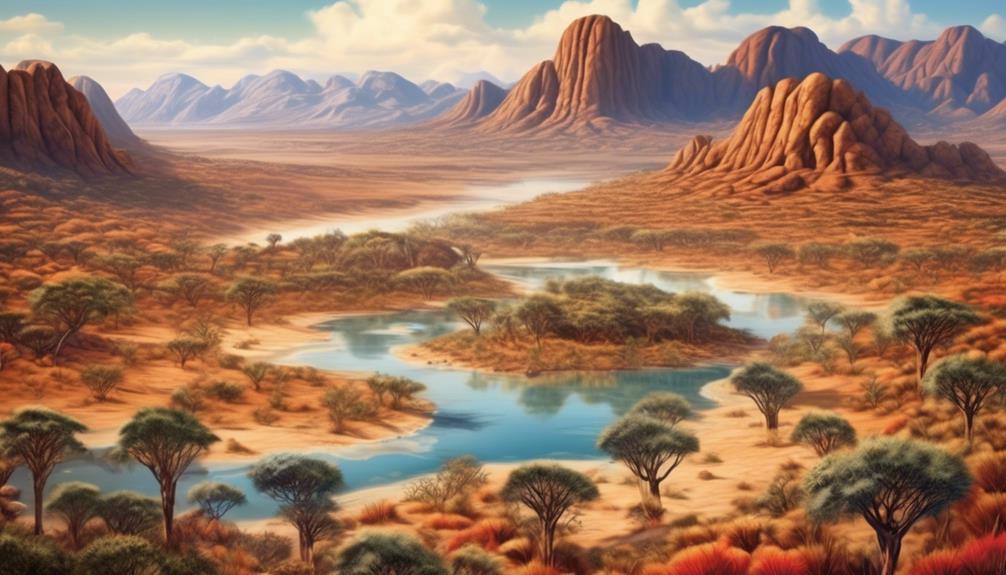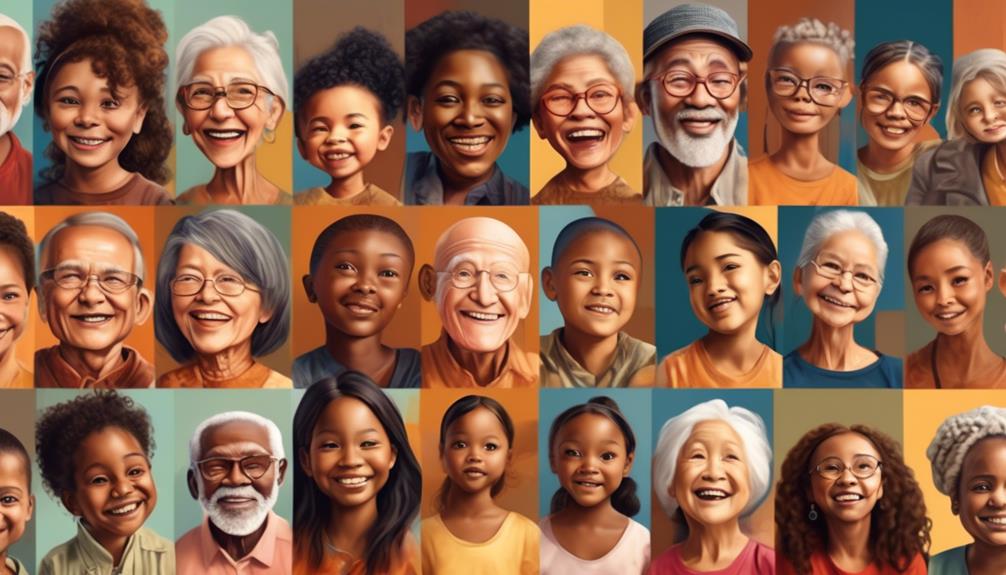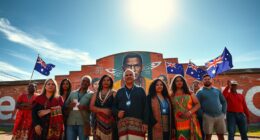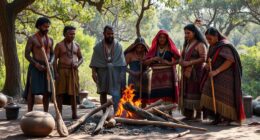As you explore historical depths, you will uncover that Indigenous drawings offer a captivating glimpse into the rich cultural heritage of Aboriginal communities.
These drawings, often created as a form of storytelling, are not simply decorative; they are laden with symbolism and carry profound meaning.
From the techniques and materials used to the evolution of Aboriginal drawings in contemporary art, the journey of these artworks through time is nothing short of fascinating.
But what truly makes Aboriginal drawings significant today? Well, the answers might surprise you.
Key Takeaways
- Aboriginal drawings provide insight into the cultural, spiritual, and historical traditions of indigenous communities.
- Techniques and materials used in Aboriginal drawings reflect a deep connection to the land and ancestral stories.
- Symbolism and meaning in Aboriginal drawings offer profound insight into cultural narratives and spiritual significance.
- Aboriginal drawings have evolved in contemporary art, combining traditional methods with modern artistic techniques and engaging in global collaborations and exhibitions.
Historical Significance of Aboriginal Drawings
The historical significance of Aboriginal drawings lies in their ability to provide a unique and invaluable insight into the cultural, spiritual, and historical traditions of indigenous communities. These drawings aren't merely artistic expressions; they're a form of cultural representation that encapsulates the beliefs, values, and daily life of the Aboriginal people.
Through the intricate lines and symbols, these drawings convey a deep connection to the land, the environment, and the ancestral stories passed down through generations. Each stroke of the ochre or charcoal on the canvas holds the essence of a rich and ancient culture, offering a window into the past and a bridge to understanding the present.
Techniques and Materials Used in Aboriginal Drawings

Exploring the techniques and materials used in Aboriginal drawings provides a deeper understanding of the cultural significance encapsulated within these artistic representations. Traditional techniques and natural materials play a crucial role in the creation of Aboriginal drawings, reflecting the deep connection to the land and the stories passed down through generations.
- Traditional Techniques: Aboriginal drawings often employ intricate cross-hatching, dot painting, and various symbolic representations. These techniques are passed down through oral traditions and are integral to preserving cultural stories and beliefs.
- Natural Materials: Aboriginal artists predominantly use natural materials such as ochre, charcoal, and bark to create their drawings. Ochre, in particular, holds immense cultural importance as it's derived from the earth and carries spiritual significance in Aboriginal culture.
- Symbolic Representation: The use of traditional techniques and natural materials allows for the incorporation of symbolic representations in Aboriginal drawings. Each stroke and color choice holds symbolic meaning, conveying stories of creation, ancestral spirits, and the natural environment.
Understanding the traditional techniques and natural materials used in Aboriginal drawings provides insight into the rich cultural traditions and spiritual connections embedded within these artworks.
Symbolism and Meaning in Aboriginal Drawings
Delving into the symbolism and meaning in Aboriginal drawings offers a profound insight into the cultural narratives and spiritual significance embodied within these expressive artworks. Aboriginal art is rich in symbolic representation, with each element holding deep cultural significance. The use of symbols in these drawings serves as a visual language, communicating stories of creation, spiritual beliefs, and connections to the land.
For example, the depiction of animals and plants may not only represent the physical world but also convey ancestral knowledge, totems, and the interconnectedness of all living things. The intricate patterns and designs often seen in Aboriginal drawings aren't merely decorative; they carry layers of meaning, reflecting the complexities of the natural and spiritual realms within Aboriginal culture.
Understanding the symbolism in Aboriginal drawings requires an appreciation of the cultural significance attached to each symbol. These drawings serve as a means of preserving and transmitting knowledge, traditions, and spiritual beliefs across generations. They provide a window into the profound connection that Aboriginal people have with their land, their ancestors, and the spiritual forces that shape their existence.
Evolution of Aboriginal Drawings in Contemporary Art

As we consider the cultural narratives and spiritual significance embodied in Aboriginal drawings, an exploration of the evolution of these artworks in contemporary art reveals a dynamic and ever-changing expression of cultural identity and artistic innovation.
In contemporary interpretations, Aboriginal drawings have evolved in response to changing cultural influences and artistic trends. The evolution of Aboriginal drawings in contemporary art is characterized by:
- Incorporation of Modern Techniques: Contemporary Aboriginal artists often combine traditional drawing methods with modern artistic techniques, such as digital media, to create innovative pieces that reflect the intersection of tradition and modernity.
- Exploration of Diverse Themes: While traditional Aboriginal drawings often focused on cultural stories and connections to the land, contemporary interpretations encompass a broader range of themes, including social issues, personal experiences, and global connectivity, demonstrating the adaptability of Aboriginal art to contemporary contexts.
- Global Influence and Collaboration: Contemporary Aboriginal artists are increasingly engaging in collaborations and exhibitions on an international scale, resulting in a cross-pollination of artistic styles and ideas. This global interaction enriches the cultural significance of Aboriginal drawings and amplifies their impact on the contemporary art scene.
The evolution of Aboriginal drawings in contemporary art reflects a vibrant and ongoing dialogue between tradition, innovation, and cultural exchange.
Preservation and Revival of Traditional Aboriginal Drawings
To understand the preservation and revival of traditional Aboriginal drawings, it's imperative to recognize the intrinsic cultural significance and historical continuity embedded within these artistic expressions. Aboriginal drawings aren't just visual representations; they carry the weight of cultural heritage and serve as a means of transmitting stories, knowledge, and spiritual beliefs across generations. The preservation and revival of traditional Aboriginal drawings are crucial in maintaining the authenticity and richness of Indigenous culture.
Efforts to preserve traditional Aboriginal drawings involve the documentation of ancient techniques, motifs, and symbols, as well as the recording of oral traditions associated with these artistic practices. Additionally, initiatives aimed at reviving these drawings often involve collaborations between contemporary artists and Indigenous communities, fostering a renewed appreciation for this unique form of artistic expression.
Frequently Asked Questions
How Do Aboriginal Communities View the Role of Non-Indigenous Artists Incorporating Aboriginal Drawing Techniques in Their Work?
When artists draw inspiration from another culture, they must consider the ethical representation of that culture and avoid cultural appropriation.
Indigenous perspectives are crucial in understanding the impact of non-indigenous artists incorporating indigenous techniques. It's essential to recognize the importance of respecting and honoring the traditions and beliefs of the culture being depicted.
Artists must engage in meaningful dialogue and collaboration with indigenous communities to ensure their work is respectful and culturally sensitive.
Are There Specific Taboos or Restrictions Around Who Can Create Aboriginal Drawings Within Indigenous Communities?
There are specific taboos and restrictions around who can create cultural representations within indigenous communities. This is a result of the deep-seated concern regarding cultural appropriation and the need for authentic indigenous representation.
It's important to respect these boundaries and consider the impact of your actions on the community. Understanding and acknowledging these cultural sensitivities is crucial in approaching the creation of indigenous art with respect and integrity.
What Are Some Common Misconceptions About the Symbolism and Meaning in Aboriginal Drawings?
Misunderstood symbolism in aboriginal drawings often leads to misconceptions. Many people engage in cultural appropriation without understanding the true meaning behind the symbols.
It's crucial to educate oneself about the significance of these drawings to avoid perpetuating misconceptions. By learning about the cultural context and symbolism, one can gain a deeper appreciation for the art and avoid unintentionally misrepresenting or disrespecting indigenous cultures.
How Do Aboriginal Communities Navigate the Balance Between Preserving Traditional Drawing Techniques and Embracing Contemporary Art Forms?
Balancing traditional drawing techniques with contemporary art forms involves preserving cultural heritage while embracing innovation. Representation is crucial, and communities must navigate the risk of cultural appropriation. This requires careful consideration and respectful collaboration with indigenous artists and communities.
Preservation of traditional methods honors the ancestors, while embracing innovation ensures the culture remains relevant. Striking a balance is essential in preserving the integrity of Aboriginal art while allowing for artistic evolution.
What Efforts Are Being Made to Ensure the Ethical Sourcing of Materials Used in Traditional Aboriginal Drawings?
To ensure ethical sourcing, it's important to be mindful of cultural appropriation and preserve traditional practices.
Contemporary integration should honor the origins of the art form. By prioritizing the ethical sourcing of materials, you can support the preservation of cultural heritage while embracing modernity.
This approach respects the community's traditions and fosters a sustainable future for Aboriginal art.
Conclusion
In conclusion, Aboriginal drawings are like windows into a rich and ancient culture, allowing us to glimpse the soul of a people with a history as deep as the earth itself.
From the techniques and materials used, to the symbolism and meaning behind each stroke, these drawings hold a wealth of knowledge and tradition.
As contemporary artists continue to evolve and preserve this art form, they ensure that the legacy of Aboriginal drawings remains vibrant and relevant for generations to come.

